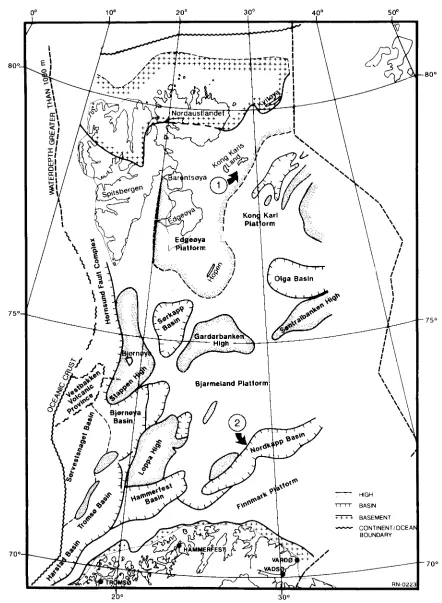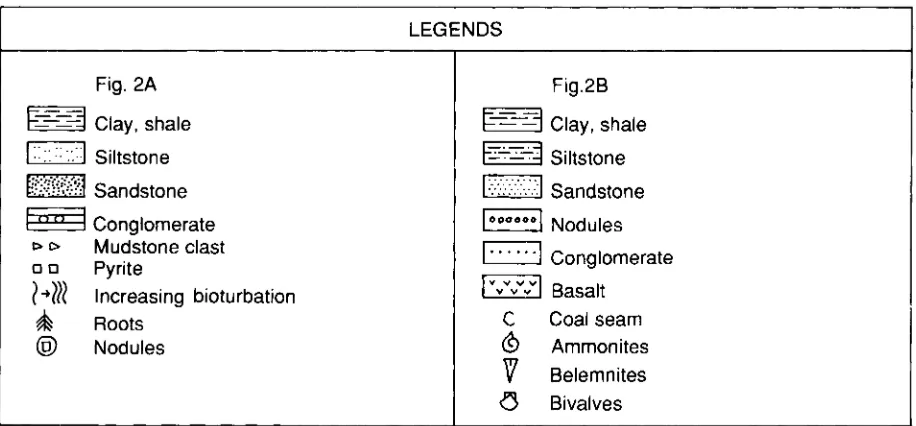Two new dinoflagellate cysts from the Middle Jurassic of the Barents Sea Region
MORTEN SMELROR
Continental Shelf and Petroleum Technology
Research
Institute,N-7034 TRONDHEIM,
NorwayABSTRACT - Two new Peridinioid dinoflagellate cyst species are described from Middle Jurassic strata of the Barents Sea
Region. Phallocysra rhomasi sp.nov. occurs in Aalenian-Bajocian sediments cored from the Nordkapp Basin and
Valvaeodinium thereseae sp. nov. occurs in Upper Bathonian-Callovian deposits cropping out on Kong Karls Land and Franz
Josef Land.
INTRODUCTION
Dinoflagellates provide good biostratigraphic resolution within the Middle and Upper Jurassic successions of the Barents Sea, and are recognized as a prime tool for dating and correlation. Consequently, in recent years extensive studies of the Jurassic dinoflagellate assemblages of the Barents Sea Shelf have been carried out by biostratigraphers at different research institutes and at oil companies involved in the exploration of this frontier region. Valuable information has been made available through the IKU Arctic Geoprogram on Svalbard and the IKU Shallow Drilling Program on the Barents Shelf. Much of the biostratigraphic information gained from the exploration activities are still unreleased, but published accounts of Jurassic dinoflagellates from these areas included the papers of Below (1987a, 1987b), Bjcerke (l978,1980a, 1980b), Bjcerke et al. (1976), Bjcerke and Dypvik (1977), Dypvik et al. (1985), Smelror (1987, 1988, 1989), Smelror and Below (1990), Smelror and Arhus (1989), Thusu (1978) and Wierzbourski andhhus (1990). In this presentpaper, two new Middle Jurassic peridinioid dinoflagellate cysts are formally described: Phallocysta thomasii sp.nov. and Valvaeodinium theresei sp.nov. Thesenew taxamay potentially serve as useful biostratigraphic markers for the Aalenian-Bajocian and Late Bathonian-Middle Callovian Stages, respectively.
SYSTEMATIC DESCRIPTIONS Order Peridiniales Haeckel 1984
Genus Phallocysta Dorhofer & Davies 1980, emend. Below 1987 Type Species. Phallocysta eumekes Dorhofer & Davies 1980,
emend. Below 1987
Phallocysta thomasi sp.nov. (PI. 1, figs 11-20) Derivation of name: Named after my son Thomas.
Holotype: P1. 1, fig. 16 Paratype: PI. 1, fig.14
Type locality and horizon: IKU shallow core 7230/05-U-02, depth: 67.29m, Nordkapp Basin, Barents Sea Region.
Description: Proximate dinoflagellate cyst, peridinioidal, more or less elongated in overall outline. The epicyst is coniform tapering into an (often prominent) apical horn. Hypocyst generally rounded with two moderately well developed half-ovaloid protrusions. Cyst wall with numerous small uniformly distributed spines (mostly accuminate/ evexate, but occasionally also capitate). No clear evidence of paratabulation has been observed, except for the archeopyle, which is anterior intercalary type 31 (i.e. comprising the l a
+
2a+
3a plates). Dimensions: Length 45-56mm, (hypocyst) width 22-40mm. Stratigraphic distribution: IKU Core 7230/05-U-02: 67.29 - 8 1.30m, Aalenian-Bajocian, Dodekovia bullula - Nannoceratopsis senex Zoneand lower Nannoceratopsis gracilis Zone of Smelror and Below (1990).
Remarks: Phallocysta eumekes Dorhofer & Davies (1980), P . erregulensis (Filotoff) Stover & Helby 1987 and P . minuta Prauss
1989 differ from Phallocysta thornasi sp.nov. in being epicavate and not possessing any prominent ornamentation. Phallocysta frommernensis Below 1987 is proximate but has a well developed
scabrate Ornamentation.
Genus Valvaeodiniurn Morgenroth 1970, emend. Below 1987 Type species. Valvaeodinium armatum Morgenroth 1970
Valvaeodinium thereseae sp.nov. (Pl. 1, figs 1-10)
Derivation of name: Named after my daughter Therese Holotype: PI. 1, fig. 5
80c
75=
70'
2 b o 3100
HIGH
-
i 7 l - T BASIN
T-m EASEMENT
-
CONTlNENTiOCEABOUNDARY
750
70°
Fig. 1. Map of the Barents Sea Region, showing the main structural elements and the positions of the type localities of the dinoflagellate species
Explanation of Plate 1
All magnification x 500, except Figures I 1-13 x 525 All illustrated specimens are housed in the type collection of the Paleontological Museum, Oslo (Norway).
(Collection numbers: PA 4386, PA 4387, PA 4404 and PMO 121469).
Figs 1-10. Valvaeodinium thereseae sp.nov. Figs 1-2, PA 4404, S-14/42-1, Q39/2 Fig.3, PA 4386, CFU-OX, M 32/3. Paratype Fig.4. PA
4387,WG-20SB, H 23/1 Fig. 5, PA 4404, S14/42-1, J S3/1.Holotype Fig. 6, PA 4387, WG-2 OXB, Q 29/0 Fig.7, PA 4387, WG-2 OX,, L 16/1 Fig. 8, PA 4387, WG-2 OX,, M 14/0 Fig. 9, PA 4387, WG-2, OXB, K 27/0 Fig. 10, PA 4387, WG-2 OX,, H 23/1
SEM-I Fig. 13, PMO 121469, 7230/0S-U-02, 67.29m, SEM-I Fig. 14, PMO 121469/05-U-02, 67.29m, M 41/2. Paratype Fig. 15,
PMO 121469,7230/05-U-02,67.29m, T 523 Fig. 16, PMO 121469, 7230/05-U-02, 67.29m A 44/4. Holotype Fig. 17, PMO 121469,
7230/05-U-02,67.29m, Q 46/0 Fig. 18, PMO 121469,7230/05-U-02, 67.29m J S1/4 Fig. 19, PMO 121469, 7230/05-U-02, 67.29m,
D 43/0 Fig. 20, PMO 121469, 7230/0S-U-02,67.29m, G 53/3
D
SlNEMURlAN - TOARCIAN WILHELM0YA SiogrenfielletI
Passet BATHONIAN EARLY CALLOVIAN ,EARLY LATE LATE IKIMMER ' KIMMER MIOOLE TO LATE TOARCIAN EARLY SlNEMURl AN /TOARC1 AN BAJOCIAN I BATHONIAN OXFORDIAN 1 IOGIAN I IOGIAN LBATHONIAN - E. OXFORDIAN E.CRETACEOUS JANUSFJELLET HELVETIAFJELLEl Retziusfjellet Harfagrehaugen" - Y Y u D a (D
r
c 3 0 0 a YUNIT A
m
I
I
1
12.3rnI
43.2m 39.2m -.--NNN h)N www EE -mw-wuI --emI
:5
I
AGE FORMATION MEMBER THICKNESS SAMPLES EXAMINED LITHOLOGY W
GRAIN SIZE w AND STRUCTURE
-
LEGENDS0 B
Fig. 2. Lithostratigraphical logs of A) core 7230/05-U-02 in the Nordkapp Basin and B) the Hhfagrehaugen section on Kongseya, Kong Karls
Land (Svalbard). The type horizons of Phallocysta thomasi sp.nov. and Valvaeodinium thereseae sp.nov. are indicated by
*.
Recordedstratigraphic distribution of these two species in the type sections are shown to the right of the lithological columns. Fig.2A is from unpublished core log prepared by G. Elvebakk. Fig.2B is from Lofaldli and Nagy (1980). See Fig 3 for key.
NORDKAPP BASIN Core 7230/05-U-02
Age Lithology
KONG KARLS LAND (SVALBARD) Harfagrehaugen section
Type locality and horizon: Svalbard, Kong Karls Land, Hftrfagrehaugen section, Sample S- 14/42- 1.
Description: Proximate dinoflagellate cyst, circumcavate, ellipsoidal to cylindrical in outline, antapex rounded. Cingulum and sulcus not marked. Ectophragm is scabrate, thin and hyaline, endophragm is generally finely granular. Ectophragm is frequently tom and disrupted. The archeopyle is apical/anterior intercalary, type 2A (i.e. comprising the 3'
+
1 a platres in the kofoidian notation). Paratabulation, except for the archeopyle and assessory archeopyle sutures is obscure. Dimensions: Endocyst: width 25-35mm, length 45-55mm.Pericyst: width 28-43mmJength 46-59mm (15 specimens measured). Stratigraphic distribution: Kong Karls Land (Svalbard)More information about the palynomorph assemblages found in the HSlrfagrehaugen and Windy Gully sections are found in Smelror (1989 and 1988, respectively). V . thereseae sp.nov. is found in the Sirmiodinium grossi Zone and Meiourogonoyanlax planoseptata- Chlamydophorella ectotabulata Zone of Smelror and Below (1990). Remarks: The morphology of the genus Valvaeodinium has been thoroughly documented by Below (1987), and to my knowldege Valvaeodinium thereseae is the only circumcavate species attributed to this genus. This species was originally described and illustrated as ?Leberidocysta sp. SA by Smelror 1988 (p. 294,296, pl. 111 figs 8,
11). In this previous description based on a limited number of
specimens, it was not possible to determine the archeopyle outline HMagrehaugen section: Retziusfjellet Member 0-12.4m above base,
Late Bathonian-Middle Callovian. Northbrook Island (Franz Josef Land, Arctic Soviet), Windy Gully section, sample WG-2 (151m above sea level), Late Bathonian.
and it was only suggested to be apical.
Manuscript received December 1990 Manuscript accepted June 1991
LEGENDS
Fig. 2A
Clay, shale
I
::I:
::::::J
Siltstone
Sandstone
ESEJ
Conglomerate
D 0
Mudstone clast
o o
Pyrite
)+?)I
Increasing bioturbation
&
Roots@
Nodules
Fig.2B
Clay, shale
Siltstone
a
Nodules
-4
[..-ij:::::r-il
Sandstone
U
Conglomerate
[y=yvyvI
Basalt
C
Coalseam
6
Ammonites
v
Belemnites
8
Bivalves
Fig.3. Legends to the lithostratigraphical logs in Fig. 2. (A: core 7230/05-U-02) B: HArfagrehaugen section).
A.
B.
REFERENCES
Below, R. 1987a. Evolution und Systematic von Dinoflagellaten-Zysten aus der Ordnung Peridiniales. I. Allgemeine Grundlagen und Subfamilie
Rhaetogonyaulacoideae (Familie Peridiniaceae). Palaeontographica Abt.
B, 205, 1-164.
Below, R. 1987h. Evolution und Systematik von Dinoflagellaten-Zysten aus
der Ordnung Peridiniales. 11. Cladopyxiaceae und Valvaeodiniaceae.
PalaeontographicalAbt. B, 206, 1-115.
Bjcerke, T. 1977. Mesozoic Palynology of Svalbard. 11. Palynomorphsafrom
the Mesozoic sequence of Kong Karls Land. Norsk Polarinstitutt Arbok
Bjcerke, T. 1980a. Mesozoic palynology of Svalhard. IV. Toarcian
dinoflagellates from Spitsbergen. Palynology, 4.57-77.
Bjcerke, T. 1980b. Mesozoic palynology of Svalbard. V. Dinoflagellates from the Agardhfjellet Member (Middle and Upper Jurassic) in Spitsbergen.
Norsk Polarinstitutt Skrifter 112, 145.167.
Bjcerke, T., Edwards,'M.B. & Thusu, B. 1976. Microplankton from the
Janusfjellet Subgroup (Jurassic-Lower Cretaceous) oat Agardhfjellet,
Spitsbergen. A preliminary report. Norsk Polarinstitutt Arbok 1974,6348.
Bjcerke, T. & Dypvik, H. 1977. Sedimentological and palynological studies
of Upper Triassic-Lower Jurassic sediments in Sassenfjorden, Spidsbergen.
Norsk Polarinstitutt Arbok 1976, 131-150.
Dypvik, H., Hvoslef, S., Bjcerke, T. & Finnerud, E. 1985. The Wilhelmgya
Formation (Upper Triassic-Lower Jurassic) at Bohemanflya, Spitsbergen.
Polar Research, 3, 155-165.
Gabrielsen, R.H.,Fcerseth, R.B., Jensen, L.N., Kalheim, J.E. &Riis, R. 1990. Structural elements of the Norwegian continental shelf, Part I: The Barents
Sea Region. NPD Bulletin, No. 6, 33pp.
Lofaldli, M. & Nagy, N. 1980. Foraminifera1 stratigraphy of the Jurassic
deposits on Kongs@ya, Svalbard. Norsk Polarinstitutt, Skrifter 112,63-95.
Smelror, M. 1987. Bathonian and Callovian (Middle Jurassic) dinoflagellate
cysts and acritarchs from Franz Josef Land, Arctic Soviet. PolarResearch,
5,221-238.
Smelror, M. 1988. Bathonian to Early Oxfordian dinoflagellate cysts and
acritarchs from Kong Karls Land, Svalbard. Rev. Palaeobot. Palynol., 56,
275-304.
Smelror, M. 1989. Chlamydophorella ectotabulata sp.nov., a gonyaulacoid
dinoflagellate cyst from the late Bathonian to the Oxfordian of the arctic.
Rev. Palaeobot. Palynol., 61, 139-145.
Smelror, M. & h h u s , N. 1989. Emendation of the dinoflagellate cyst genus
Crussolia Wolfard & van Erve 198 1, and description of C. dalei n.sp. from
the Callovian of Svalbard. N.Jb. Geol. Paluont, Mh. 1988, 37-46.
Smelror, M. &Below, R. 1990. Dinoflagellate biostratigraphy of the Toarcian
to Lower Oxfordian (Jurassic) of the Barents Sea Region. Abstract,
Norwegian Petroleum Society International Conference on Arctic Geology
and Petroleum Potential, Troms@,l990, p.50.
Thusu, B. 1978. Aptian to Toarcian dinoflagellate cysts from Arctic Norway.
In: B. Thusu (ed.): Distribution of biostratigraphically diagnostic
dinoflagellate cysts and miospores from the Northwest European continental
shelf and adjacent areas. Continental Shelffnst. Publ., 100,61-95.
Wierbowski, A. & Arhus, N., 1990. Ammonite and dinoflagellate cyst
succession of an Upper Oxfordian-Kimmeridgian black shale core from the
Nordkapp Basin, southern Barents Sea. Newsl. Stratigr., 22,7- 19


